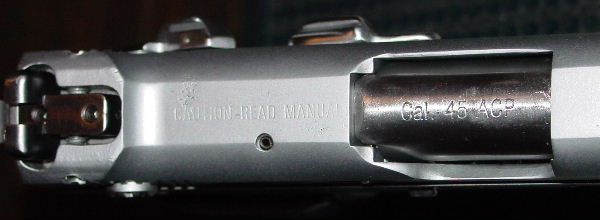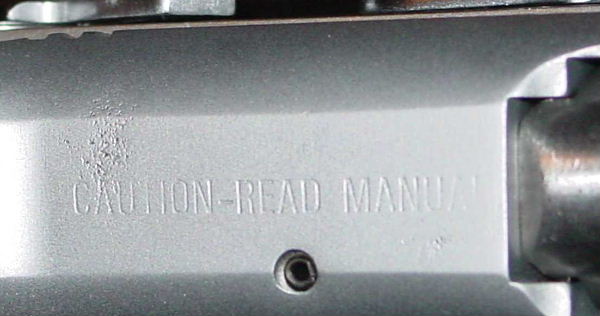|
Bren Ten Debate: Safe Queen vs. Shooter
Just over 20 years ago a new firearms company hit the market with a brand new gun and cartridge. The Bren Ten 10mm Auto represented
an exciting new concept in combat handguns, but unfortunately the company of Dornaus & Dixon survived only a few short years
and produced less than 1,500 total guns. Though the company failed, the gun's excellent inherent design characteristics, combined
with its prominent roll in the '80s hit television series "Miami Vice," has helped it to establish a small, but loyal following
among firearms collectors.
When the Bren comes up in conversation in gun groups what most people remember is the character "Sonny Crockett" (played by
Don Johnson) blasting bad guys (along with the occasional helicopter) with his mighty Bren Ten. Many, like myself, have waited
a long time and spent a good chunk of our "gun funds" to finally acquire a Bren Ten. When we finally became the proud owner
of a Bren the first thing we wanted to do is hit the range to give a few imaginary drug kingpins their 10mm just deserts!
There are, however, certain issues that must be taken into consideration before firing your Bren Ten.
Those who have followed the Dornaus & Dixon/Bren Ten story for some time know that there is another side to "Detective Crockett's"
helicopter-blasting 10mm. The issue of concern deals with metallurgical imperfections in the castings which have, on a number
of occasions, led to catastrophic failures of certain major parts. It is very true that there are individuals who have shot
their Brens extensively with full-power ammunition with no ill effect, but just because it's been done doesn't automatically
mean it's a wise choice.
I have asked Bruce (a long time Bren Ten collector with extensive background and experience with the Bren Ten and its history)
to discuss the technical aspects of situation. This way Bren owners (or potential Bren buyers) will at least be able to make
an informed decision when it comes to the "safe queen vs. shooter" debate.
So is it safe?
The promotion and release of the new Miami Vice feature film, along with the running of the original television series
on both the TVLand and Sleuth cable channels, has brought renewed interest in Sonny Crockett's weapon of choice. In the previous
nine months (2005-2006), prices of all Bren Ten models has risen by as much as 50% in some instances and many new owners have
entered the magical, mystical world of Brendom. Many of these said owners want to head to the range with their recently acquired
pistol, stoke it with ammunition and "let drive." This has prompted me to wonder if we'll be getting news of a serious accident
shortly.
I have formulated two very strong opinions over the years regarding Bren Tens. The first is that guns in collectible condition
should not immediately be sent to the nearest hard chrome shop. The second is that they are for fondling, but not for shooting.
The following exercise is an explanation of the latter position.
Bren Ten pistols have the deserved reputation of being prone to catastrophic failure. This is not an urban legend. The problem
encompasses all models. An enormous red light should go on to anybody considering using their gun as a shooter because of
the fact that the ratio of safe queens to shooters is extremely high while total production numbers are very low. At
the top of the list of concerns is slide failure caused by fractures. Those who were subscribers to the old Bren Ten Association
Newsletter know that Dep personally viewed the mortal remains of a Marksman Special which gave up the ghost due to a slide
fracture. This gun was in the old Marksman Shop (Yes, that Marksman Shop). The slide was split into two pieces. According
to John Morgan, the shop's owner, the shooter had been practicing on an indoor range when the incident occurred. As a round
was touched off, the rear half of the slide whizzed past the shooters head and buried itself in the wall behind the firing
line. The "lucky" shooter's ear was nicked in the process. Seems that this individual was an attorney and it took a new Colt
Gold Cup, provided by John, to calm the waters.
When Dornaus and Dixon was failing, an interim entity called the Bren Ten Corporation was formed with the help of Richard
Voit. One of the first orders of business was to redesign the Bren Ten in order to strengthen it and make it easier to mass-produce.
This was actually the genesis of the Falcon project. Why was this the first order of business? One of the things Richard Voit
took possession of was a box of fractured Bren Ten slides.
Based on what I've learned over the years, the slide issues stem from a number of problems. All investment castings for major
Bren Ten components came from the same Texas foundry. All Bren Ten slides, regardless of model, are made from the same casting
and all therefore share its weakness. The castings, especially those for the slides, tended to be porous. Dornaus & Dixon's
budgetary constraints precluded the luxury of in-house testing for hidden defects. Add to this the usual growing pains and
quality control problems and "presto," all the ingredients for major problems are in place!
Imagine that there is an area containing dozens of minute voids between the bottom of the ejection port and the bottom of
the slide. These are below the surface and unseen. Every time the weapon is fired, stress in this area causes microscopic
fissures emanating from one void to travel in all direction including towards other voids. As the firing continues, the dots
are connected, this area is progressively weakened to the point that a crack suddenly forms and the part fails in that area.
This process is what appears to be the underlying condition resulting in the majority of the slide failures.
Consider this fact. All 251 Marksman Specials ordered by the Marksman Shop were actually delivered to them. However, not all
of the Marksman Specials were sold by the Marksman Shop. Why? John Morgan returned a substantial number of the guns to the
factory (after removing the owners manuals and magazines) following the Gold Cup Affair because they had slides which had
obvious porous areas visible. Almost all of these guns never returned to the shop although I know for a fact that they are
in circulation. I happen to own a Marksman with a porous slide and have included photos of the main affected areas.


Defective investment castings are not the only issue with Bren Ten slides. A couple of other thing have been related
to me by a well know weapons smith familiar with the Bren Ten. Compare a full size models slide with that from a Special Forces
Model and if you look closely, you'll see that the notch in the slide for the slide stop is closer to the edge of the ejection
port on the four inch gun than on the five inch full sized models. Consider also that the slide velocity is greater for the
shorter slide compared to the longer with identical ammunition. This person felt that this area was structurally critical
and an obvious weak spot. I've done this comparison with the guns that I own and it appears to be true. This individual also
feels that the Special Forces Light slides may also suffer from hydrogen embrittlement. This is a metallurgical defect that
occurs during the hard chrome plating process. Platers working on firearms have been aware of this problem for some time and
have developed techniques which circumvent the defect but this wasn't the case 20+ years ago.
As much as I love all fifteen Bren Tens I currently own, the above is why I've shot none of them and advise anyone who will
listen to do the same. That being said, I also realize that there are those who believe that guns are made for shooting and
intend to shoot the Bren Ten no matter what. What then can be done to reduce the odds of an accident? I would advise, in the
strongest terms possible, anybody planning on shooting a Bren Ten to have both the frame and slide x-rayed and magnafluxed.
This should turn up any hidden existing weak spots in structurally relevant areas. This should be done whether the gun has
been fired or not. Remember that most catastrophic failures are the result of progressive damage similar to what I described
previously. I do believe that hydrogen embrittlement can only be uncovered by metallurgical testing which may be impractical.
It has been suggested that shooting reduced power ammunition can't hurt, but my personal feeling is that this technique is
of dubious value in view of the fact that all models have been known to fail, including the .45 ACP Marksman Specials.
For my part, I've made a conscious decision to save my expensive collectible firearms and priceless (to me) face by just holding
and admiring my Bren Tens. In essence, I've come to grips with the fact that they are what they are. There is a reason that
the gun underwent a major redesign which resulted in the Falcon. I've tried in this article to present a lucid and clear explanation
of the dangers I perceive. My intent is to short-circuit what I consider an accident ready to happen.
Please take time to consider the above before heading to the range!
Bruce
BREN-TEN.com cannot, of course, tell anyone what to do with their own Bren Ten. We can, however, make recommendations based
on the information we have collected and our own personal experiences with the Bren. Therefore, BREN-TEN.com makes the following
recommendations:
1) Bren Ten pistols, regardless of model or caliber, should not be fired at all.
2) If a particular Bren Ten is going to be fired, then it is of vital importance that the gun be x-rayed and magnafluxed to
test for metallurgical imperfections.
3) Even after testing, avoid using full-power ammunition. As mentioned, even standard power level ammunition will cause cumulative
damage in a gun with metallurgical imperfections, but at least this will hopefully save wear and tear on other difficult to
replace parts.
Our final recommendation deals with more with the collector status of the Bren, and not its safety or function. As has been
stated numerous times on the website, there were less than 1,500 total Bren Tens produced. Altering or modifying a gun that
is already limited in number can have a negative overall effect on the collector status of that particular model. Because
of this we also make the final recommendation:
4) If a "Miami Vice" Bren is desired, then purchase one that has already had the slide hard chromed. Every time
another Bren is "Viced" the number of original condition Bren Tens is reduced.
We understand that these recommendations will not be universally accepted. It is our hope though, that by sharing this information
and taking a definate position on the matter we will help to protect the status and collectability of all existing Bren Ten
pistols. Thank you.

|

